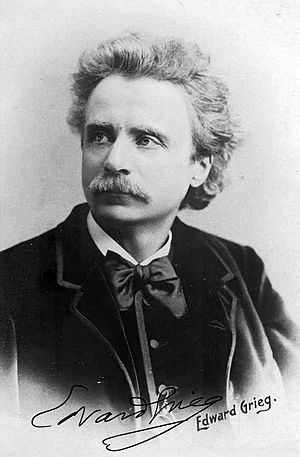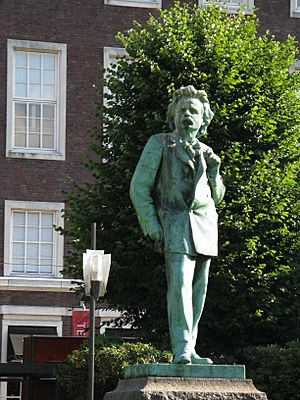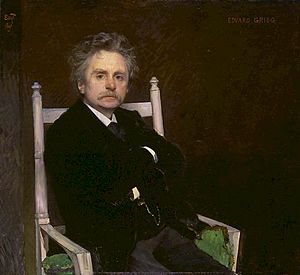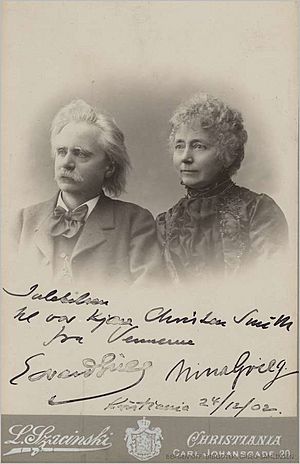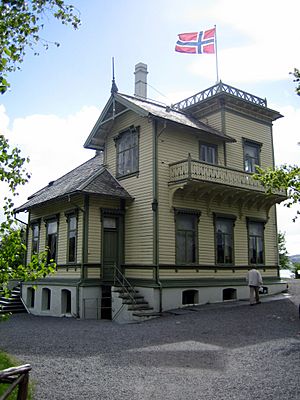Edvard Grieg facts for kids
Edvard Hagerup Grieg (born June 15, 1843 – died September 4, 1907) was a famous Norwegian composer and pianist. He is known as one of the most important composers of the Romantic era. His music is still played by orchestras and pianists all over the world.
Grieg used Norwegian folk music in his own pieces. This helped make Norway's music famous and also helped build a strong national identity. He did this much like Jean Sibelius did in Finland and Bedřich Smetana in Bohemia.
Edvard Grieg is the most celebrated person from the city of Bergen. Many statues show him, and important places are named after him. These include the city's biggest concert hall (Grieg Hall), a top music school (Grieg Academy), and a professional choir (Edvard Grieg Kor). The Edvard Grieg Museum at his old home, Troldhaugen, keeps his memory alive.
Contents
Who Was Edvard Grieg?
Edvard Hagerup Grieg was born in Bergen, Norway. At that time, Norway was part of Sweden–Norway. His father, Alexander Grieg, was a merchant and a British Vice-Consul. His mother, Gesine Judithe Hagerup, was a music teacher.
Edvard grew up in a very musical family. His mother was his first piano teacher. She started teaching him when he was just six years old.
In 1858, when Grieg was 15, he met the famous Norwegian violinist Ole Bull. Bull was a family friend. He saw Edvard's great talent and convinced his parents to send him to a special music school. This school was the Leipzig Conservatory in Germany.
Grieg studied piano at the conservatory. He enjoyed going to the many concerts in Leipzig. However, he did not like the strict rules of the school. He once wrote that he felt he left the conservatory "just as stupid as I entered it." Still, he learned a lot there.
What Was Grieg's Career Like?
In 1861, Grieg played his first concert as a pianist in Sweden. In 1862, he finished his studies. He then played his first concert in his hometown of Bergen.
In 1863, Grieg moved to Copenhagen, Denmark. There, he met other composers like J. P. E. Hartmann and Niels Gade. He also met Rikard Nordraak, who wrote Norway's national anthem. Nordraak became a close friend and a big inspiration for Grieg. When Nordraak died in 1866, Grieg wrote a special funeral march for him.
On June 11, 1867, Grieg married his cousin, Nina Hagerup. She was a talented singer. In 1868, they had a daughter named Alexandra. Sadly, Alexandra died in 1869.
During the summer of 1868, Grieg wrote his famous Piano Concerto in A minor. This was while he was on holiday in Denmark. The concerto was first performed in Copenhagen in 1869.
In 1868, the famous composer Franz Liszt heard about Grieg's talent. Liszt wrote a letter to the Norwegian government. This helped Grieg get money to travel. Grieg and Liszt met in Rome in 1870. Liszt was very impressed with Grieg's music. He even played Grieg's Piano Concerto from the music sheet, which amazed everyone.
In the 1870s, Grieg became friends with the writer Bjørnstjerne Bjørnson. They both wanted Norway to have more self-rule. Grieg set some of Bjørnson's poems to music. Later, Grieg wrote music for Henrik Ibsen's play Peer Gynt. This music became very popular.
Grieg worked closely with the Bergen Philharmonic Orchestra. He was their Music Director from 1880 to 1882. In 1888, Grieg met the Russian composer Tchaikovsky. Tchaikovsky thought Grieg's music was beautiful and special.
In 1897, Grieg and his wife performed some of his music for Queen Victoria at Windsor Castle.
Grieg received two special honorary degrees. One was from the University of Cambridge in 1894. The other was from the University of Oxford in 1906.
Grieg's Later Life
The Norwegian government gave Grieg a pension when he got older. In 1903, Grieg made some early gramophone recordings of his piano music in Paris. These recordings can still be heard today. He also made special piano rolls that could play his music automatically.
In 1899, Grieg canceled his concerts in France. This was to protest a political scandal happening there. Grieg believed in basic human rights.
In 1906, Grieg met the composer and pianist Percy Grainger in London. Grainger loved Grieg's music. Grieg was very impressed with how Grainger played his "Norwegian Peasant Dances." He called Grainger a "genius."
Edvard Grieg passed away in Bergen, Norway, on September 4, 1907. He was 64 years old. He had been ill for a long time.
His funeral was a very large event. Between 30,000 and 40,000 people came to honor him. As he wished, his own Funeral March in Memory of Rikard Nordraak was played. Grieg was cremated, and his ashes were placed in a mountain tomb near his home, Troldhaugen. Later, his wife's ashes were placed there too.
Grieg's legacy is still strong today. There is a large statue of him in Seattle. One of the biggest hotels in Bergen is named after him. Even a large crater on the planet Mercury is named Grieg.
What Music Did Grieg Write?
Grieg wrote many different kinds of music. Some of his early works include a symphony and a piano sonata. He also wrote three violin sonatas and a cello sonata.
He is most famous for the music he wrote for Henrik Ibsen's play Peer Gynt. This includes the very well-known pieces "In the Hall of the Mountain King" and "Morning Mood". Grieg once joked that "In the Hall of the Mountain King" sounded like "cow-pies" and "trollish self-satisfaction," but he hoped people would see the humor in it!
Grieg's Holberg Suite was first written for piano. Later, he arranged it for a string orchestra. Grieg also wrote many songs. He used words from famous poets like Heinrich Heine, Johann Wolfgang von Goethe, and Hans Christian Andersen.
Many pianists have recorded Grieg's complete piano music. Grieg himself recorded some of his piano works before he died in 1907.
Selected Works by Edvard Grieg
- Piano Sonata in E minor, Op. 7
- Violin Sonata No. 1 in F major, Op. 8
- Concert Overture In Autumn, Op. 11
- Violin Sonata No. 2 in G major, Op. 13
- Piano Concerto in A minor, Op. 16
- Incidental music to Bjørnstjerne Bjørnson's play Sigurd Jorsalfar, Op. 22
- Incidental music to Henrik Ibsen's play Peer Gynt, Op. 23
- Ballade in the Form of Variations on a Norwegian Folk Song in G minor, Op. 24
- String Quartet in G minor, Op. 27
- Two Elegiac Melodies for strings or piano, Op. 34
- Four Norwegian Dances for piano four hands, Op. 35
- Cello Sonata in A minor, Op. 36
- Holberg Suite for piano, later arranged for string orchestra, Op. 40
- Violin Sonata No. 3 in C minor, Op. 45
- Peer Gynt Suite No. 1, Op. 46
- Lyric Suite for orchestra, Op. 54
- Peer Gynt Suite No. 2, Op. 55
- Four Symphonic Dances for piano, later arranged for orchestra, Op. 64
- Haugtussa Song Cycle, Op. 67
- Sixty-six Lyric Pieces for piano in ten books, including: Arietta, To the Spring, Little Bird, Butterfly, Notturno, Wedding Day at Troldhaugen, and March of the Dwarfs.
- In The Hall of the Mountain King
See also
 In Spanish: Edvard Grieg para niños
In Spanish: Edvard Grieg para niños
- Bust of Edvard Grieg, University of Washington, Seattle
- Grieg (crater)
- Grieg's music in popular culture
- Peer Gynt Prize
- Song of Norway


